On a clear-cold Sunday afternoon with crunchy snow on the ground, Kat Mayerovitch of Wilder walked through one of her favorite places, Kilowatt Park. Junction editor Isaac Lorton, also a Wilder resident and river trail enthusiast, tagged along to chat with Kat about The Kilowatt Project – a passion project sharing weekly poetry, little moments of insight, and photographs capturing the day-to-day movement of Wilder’s versatile parks and trail network along the Connecticut River. The project is a year-long online ode to Kilowatt Park North, Kilowatt Park South, and the stretch of land that connects the two – Kat likes to think of it all as one unified park. Each Monday in 2022, Kat posts a poem about her experience in the park that week and highlights observations on the project’s Instagram account, “because every park deserves a poet.”
Isaac: How did The Kilowatt Project come about?
Kat: I’ve lived in Wilder for about four years now. I moved here from Indianapolis of all places – a bit of a change of pace. Whenever I move somewhere, the first thing I go looking for are, what are the trails, what are the parks that I can walk to? What’s walkable for me, and this is kind of it. The Hazen trail, of course, is lovely, too. Just up the road a bit.
I: It’s hard to get to walking, though.
K: Yeah, I’m lucky that I moved real close. I take the bike path and then I walk down the hill, and then I walk on the street for a bit and cross the road, and it’s always a little bit sketchy.
I: Right?! That’s what I do too! I wish all this were a little bit more connected.
K: I’ve been here a lot. Mostly more in the summertime, until recently. I work for King Arthur on the social media team, so I spend all day writing and writing, but I’m writing things like, ‘Yes, your sourdough starter is supposed to smell like that. Don’t ruin it.’ And I haven’t been exercising the creative part of my brain as much. And then, especially since the pandemic, we’re not going out to plays and poetry readings, live music, and all these things, so I just really had been wanting to make myself do that and be a little more comfortable on a regular basis and not so perfectionist about it because there’s a lot of stuff where I’ve got those tendencies and it never sees the light of day because I’ll work on it for six months and then finally it’s okay, but then it’s not timely any more or …
I: It doesn’t mean as much as it did in the moment?
K: Right! I guess to sort of back it up: When I was in high school, in Ohio, there’s this little lake down there called Lake Abrams – it’s not the most popular one… The highschoolers – the environmental science kids, which was not me because I really didn’t do well in science – were doing a bunch of conservation stuff, and were like, ‘No one cares about this lake.’ And someone – I don’t know if it was the French teacher, maybe – said the issue is no one writes songs about Lake Abrams. So they took the student songwriters group – all of them – and they packed them up and took them to Lake Abrams and said, ‘Go! Write songs about Lake Abrams. Make art about Lake Abrams.’ I’ve always thought about that: if you love something, make art about it. I’ve always kind of felt that way. Every place that someone loves should have its own poet laureate. People should be like, ‘I want to see the dances about the community garden,’ or like ‘I want to hear the songs about the Hazen Trail,’ or whatever it is.
I: Praising what makes local life so fun and happy.
K: Exactly! Like look at this! Look at the texture on there! That’s so cool! (She says gesturing to some tree bark). Right now, especially in this moment – I mean some people are traveling again; I’m really not – so my world, geographically, is a lot smaller than it was even four years ago. But I feel like that doesn’t mean it has to be small.
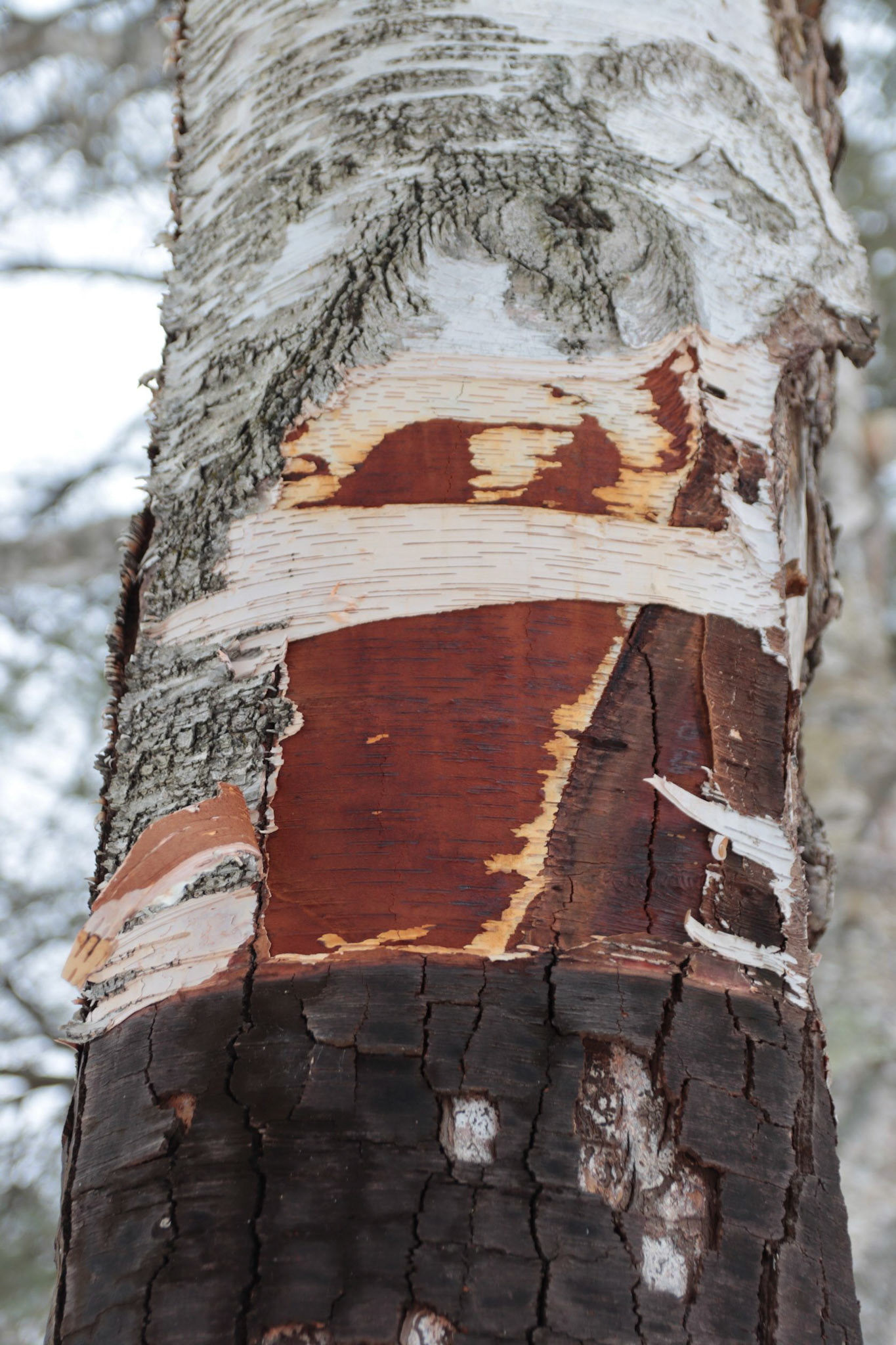
Photo by Isaac Lorton

Photo by Isaac Lorton

Photo by Isaac Lorton
I: The reason I am so excited about the Kilowatt Project is because I moved to Wilder almost a year ago. When I got here, I found joy walking the river trail. Like walking along here and you see people skating on the river! (People skating by on the Connecticut).
K: I would never dare! But that’s amazing!
I: Or kayaking. It’s great! I’ve been taking thousands of photos of this park because it’s so beautiful.
K: Same.
I: It is this little gem along the river.

Photo by Isaac Lorton
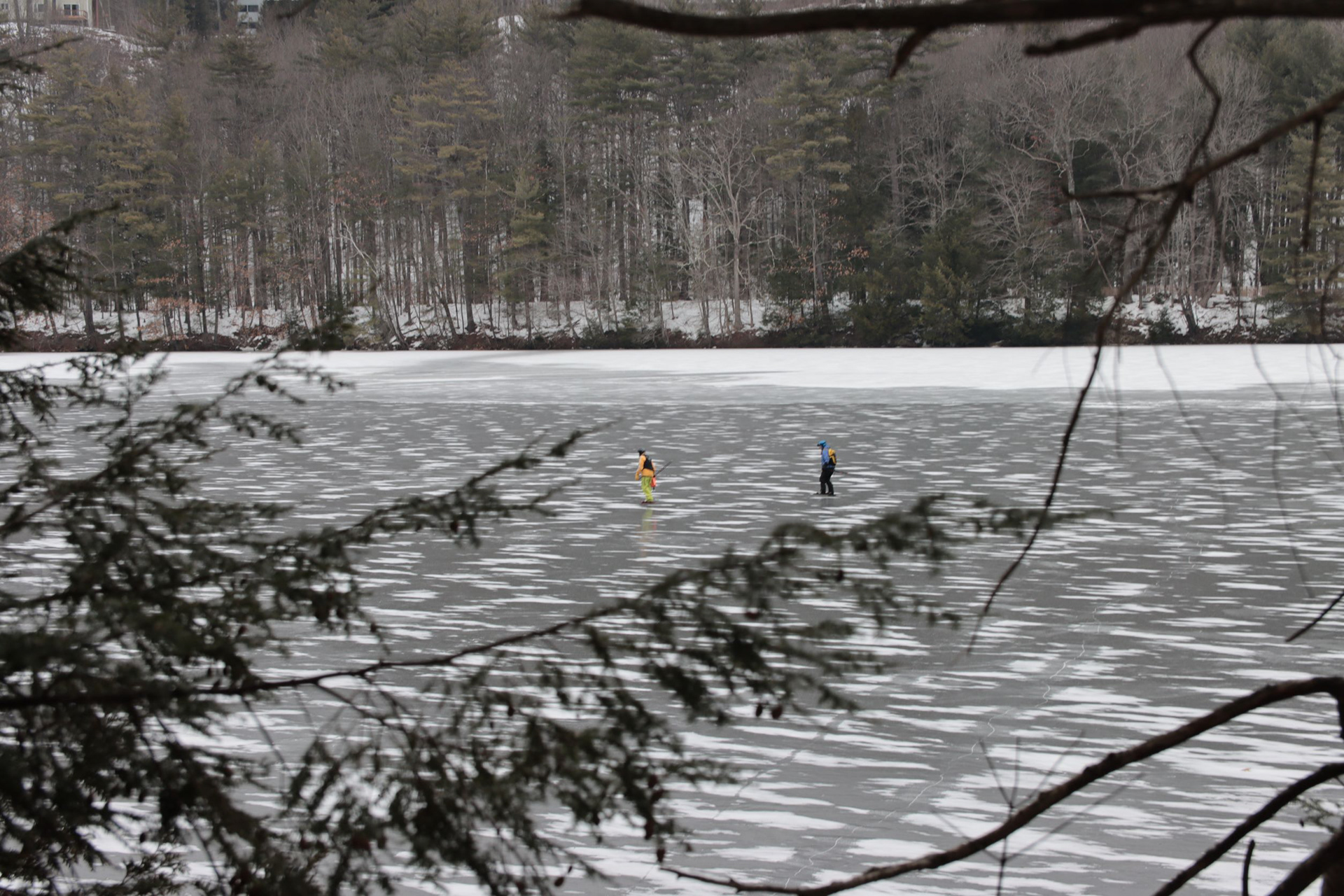
Photo by Isaac Lorton
I: It is this little gem along the river.
(A pack of happy dogs barking)
I: So that’s the dog club? The Wilder Dog Club?
K: They’re like the real guardians of this park. This park belongs to the dogs.
I: It really does. The number of dogs out here running up and down the trail. I don’t have a dog, but I love walking along and the dogs will come up to you so excited to meet you.
K: This past year the town had all this back to the very ground (Gesturing to the snowy ground under the power lines). Before there were so many blackberries growing here. All summer, you could eat the crap out of them. There were so many. But they’re super invasive, so I totally get why they mowed this whole strip down.
I: (Coming to a split in the trail) So, you go this way? Or that?
K: I’ll go either.
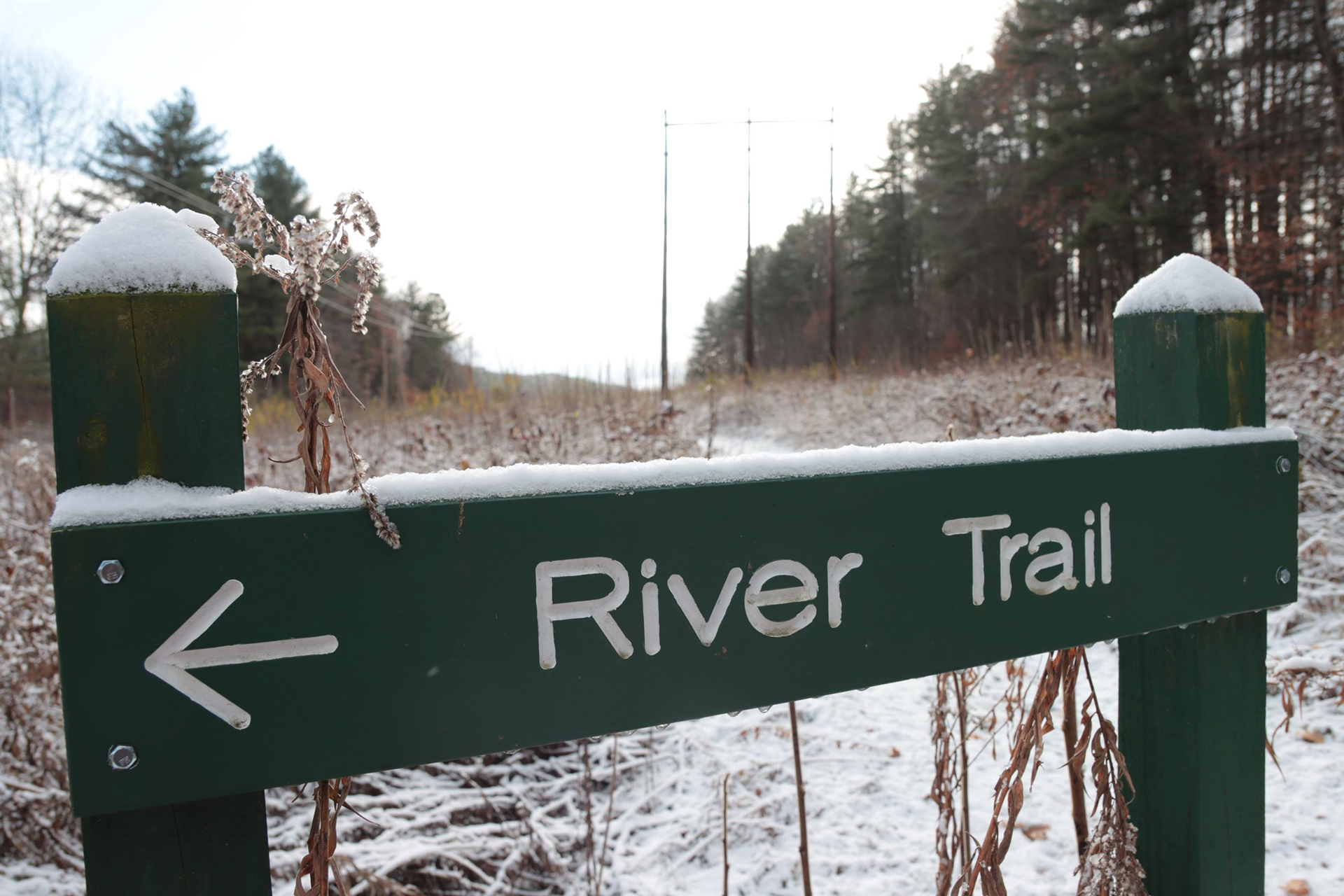
Photo by Isaac Lorton
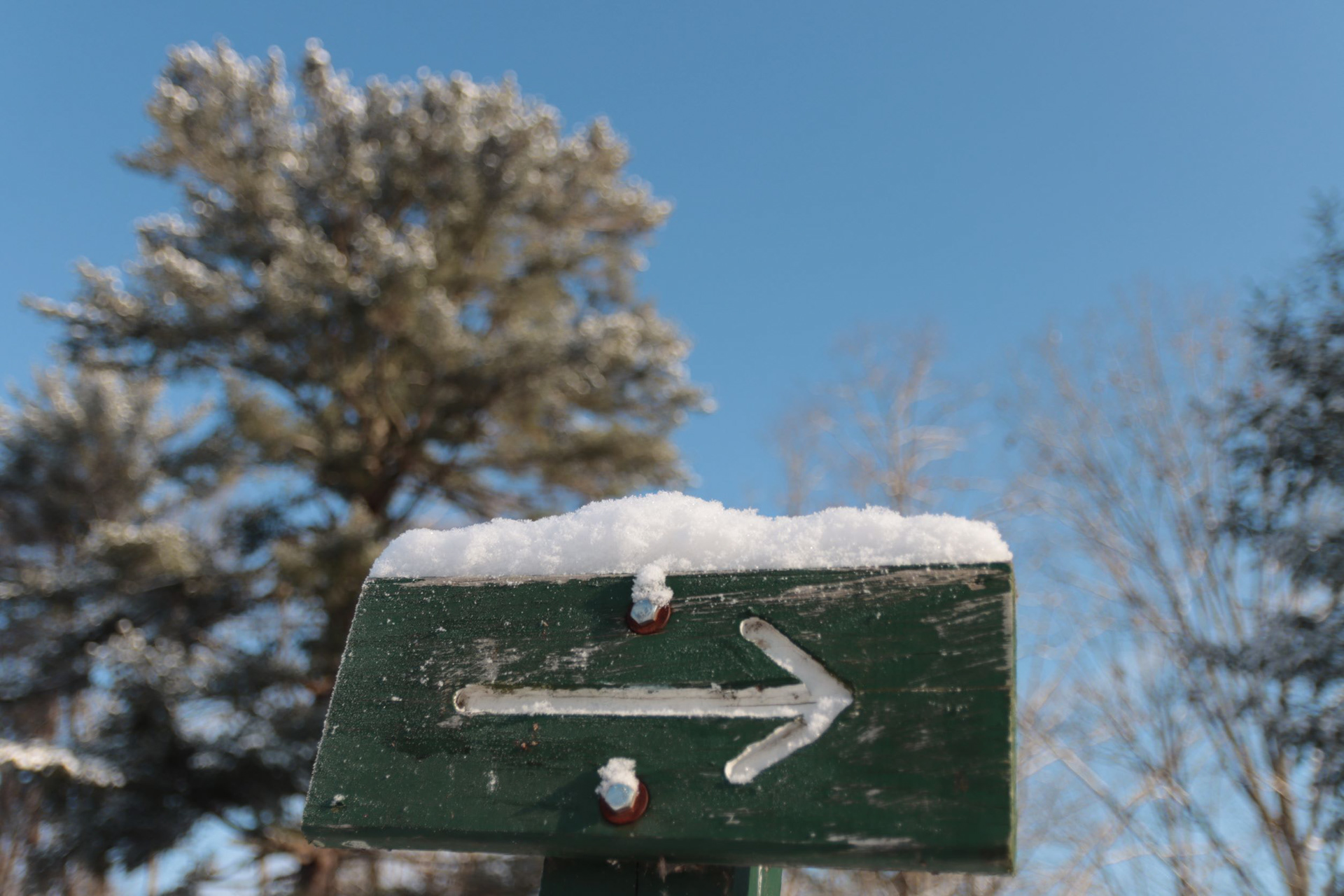
Photo by Isaac Lorton
I: I find myself on this trail trying to find something new or different with it. Do you have any favorite trees along the path? Because that’s what I think I enjoy most about this trail.
K: Oh definitely the loop-de-loop tree. It’s so visually stunning. And I take a million pictures of this tree over here that hangs by the benches. You see a lot of woodpeckers right around here.
I: Yeah, it’s like the woodpecker mecca right here. You posted a photo on Instagram about someone stepping in a hole the other day –
K: It’s right there (pointing to it)!
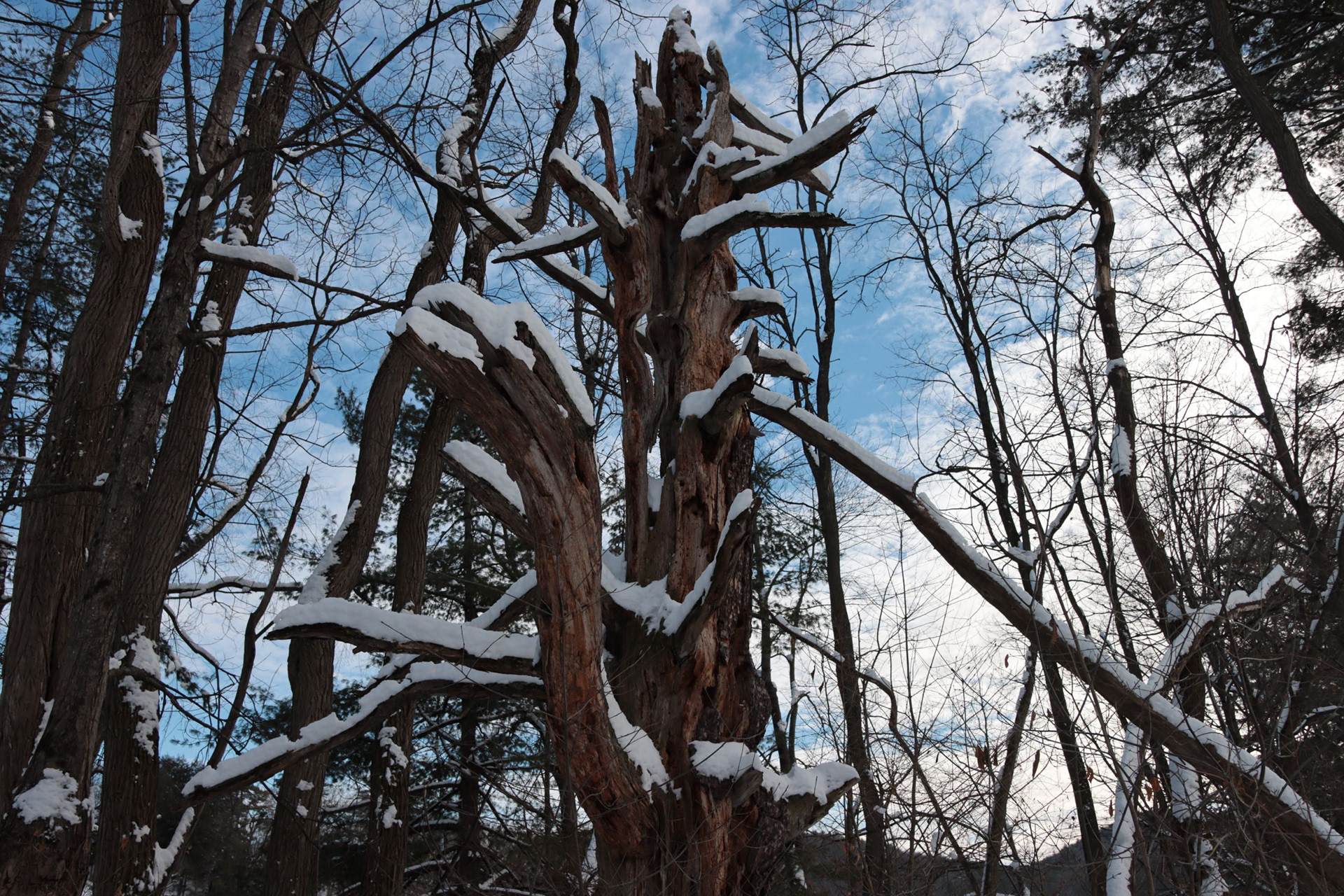
Photo by Isaac Lorton
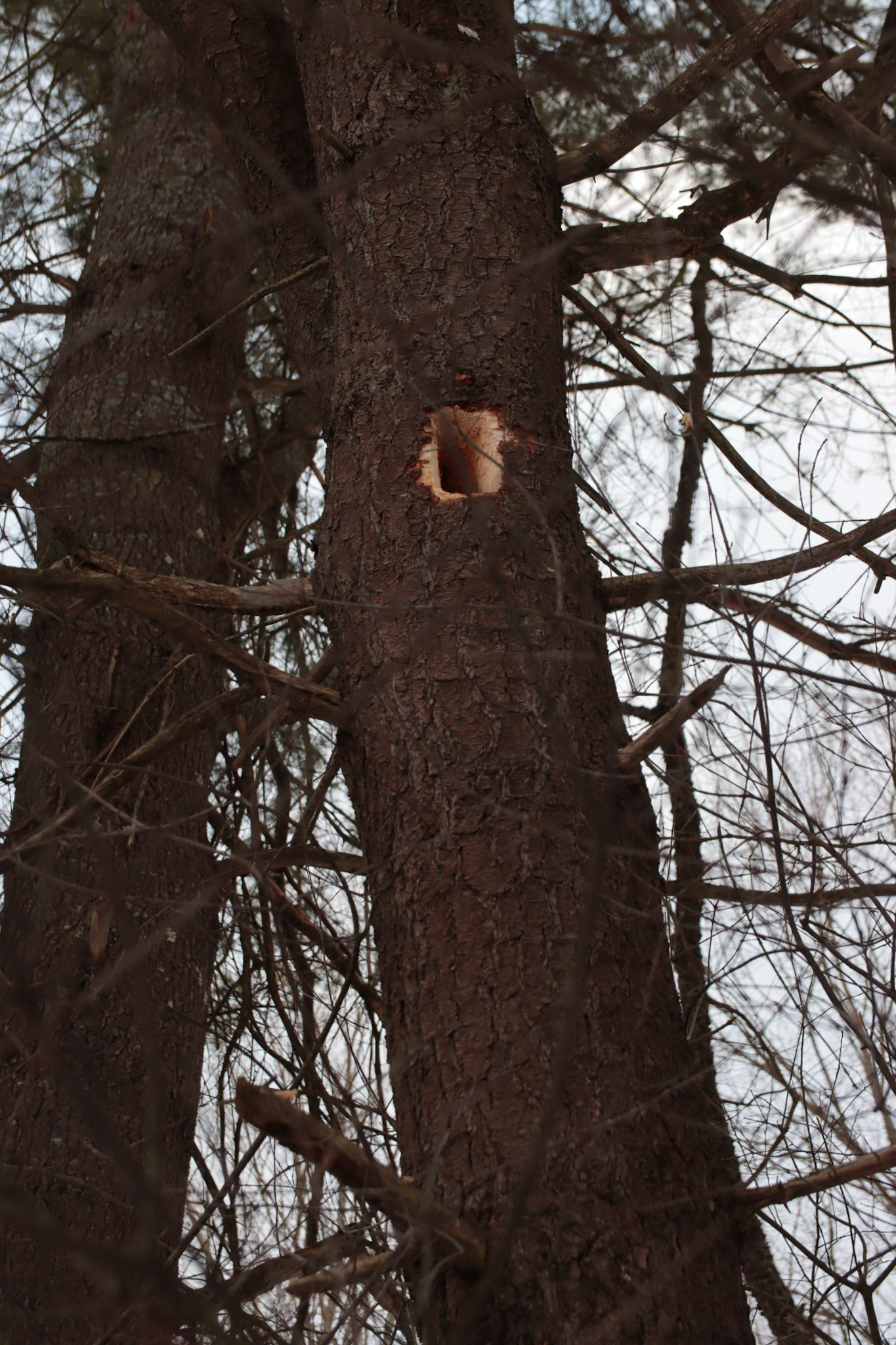
Photo by Isaac Lorton

Photo by Isaac Lorton
I: It wasn’t me, but I had done that the day before over by the boat dock. I went to take a picture of some ice sticking up, and my foot went through and got all wet. Unfortunately, it was at the beginning of my walk, so I had to head home. My pant leg was all frozen. Fortunately, it didn’t get any water in my shoes.
K: It’s interesting that all the funky patterns on the ice that were there two to three days ago, are just completely gone now. It’s wild. I have no idea what causes that.
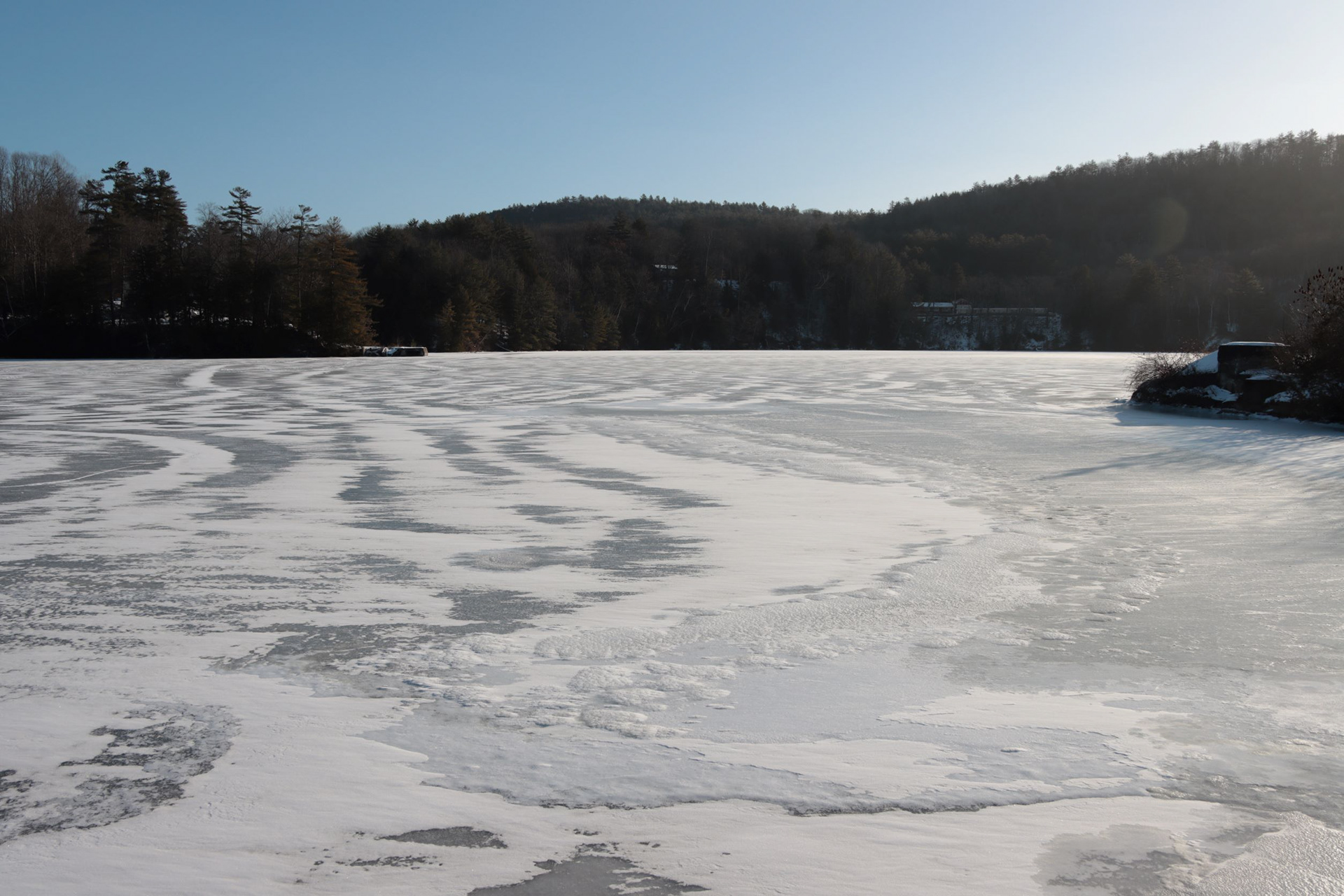
Photo by Isaac Lorton
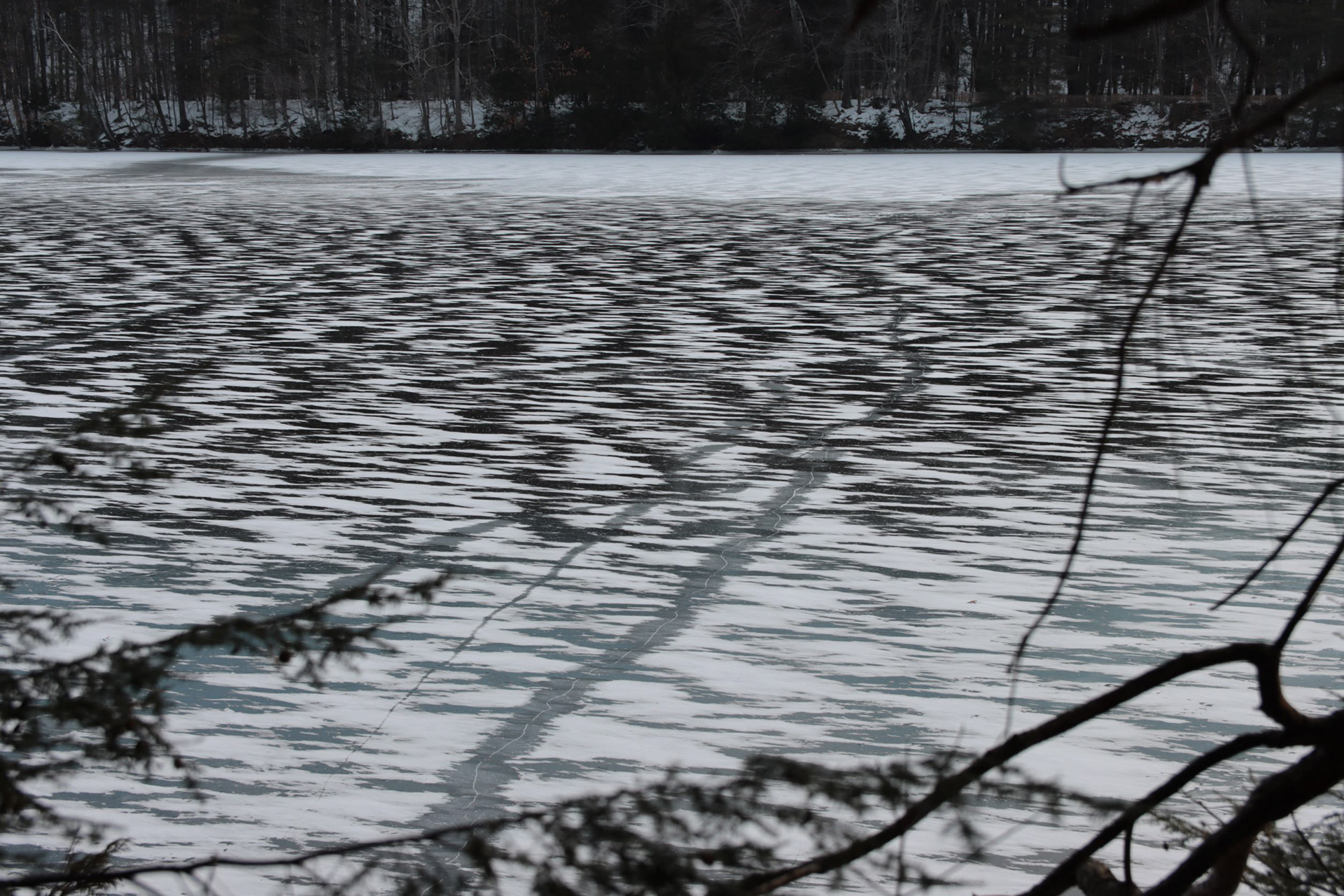
Photo by Isaac Lorton
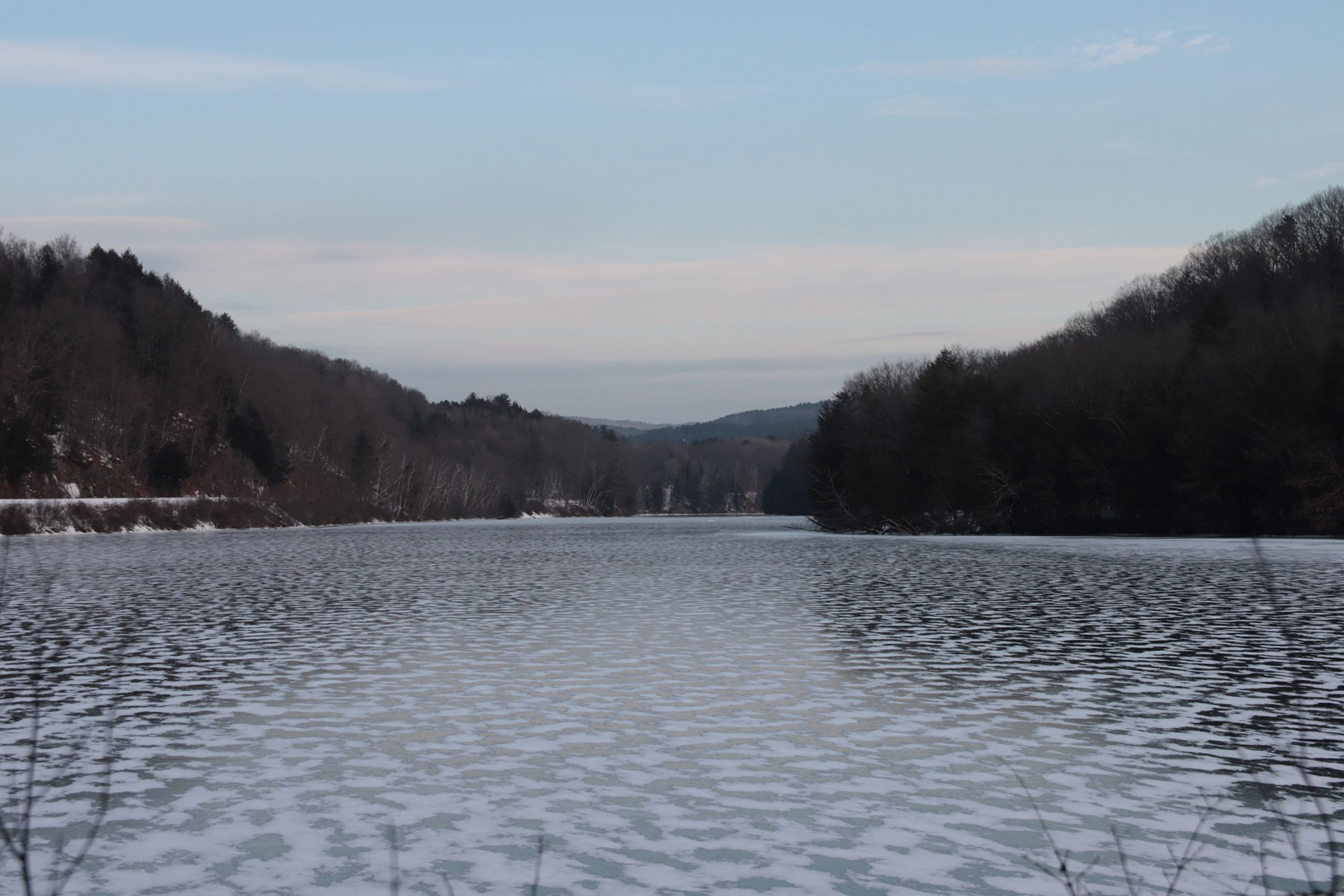
Photo by Isaac Lorton
I: Yeah, it looked like the little snow drifts had emphasized the pattern.
K: It changes so much. And that’s one of the things I love about this park. We always talk about, ‘oh, there are seasonal changes,’ and you think of them in the big chunks you’re taught about in kindergarten. It’s winter, there’s ice and snow. And then there’s spring, and it melts, and there’s flowers and mud. You don’t think about how it crystallizes and then it melts a little, and there’s these weird wavy things and then it gets snowed on top of. All those crazy changes happened within a week.
I: Yeah, the subtle day-to-day changes that you see. I’m always amazed at the flowers that pop up, especially in the summer when it’s hot and dry, and then it rains, and everything blooms out and blossoms out again. It’s awesome.
K: Or you get stuff like this.
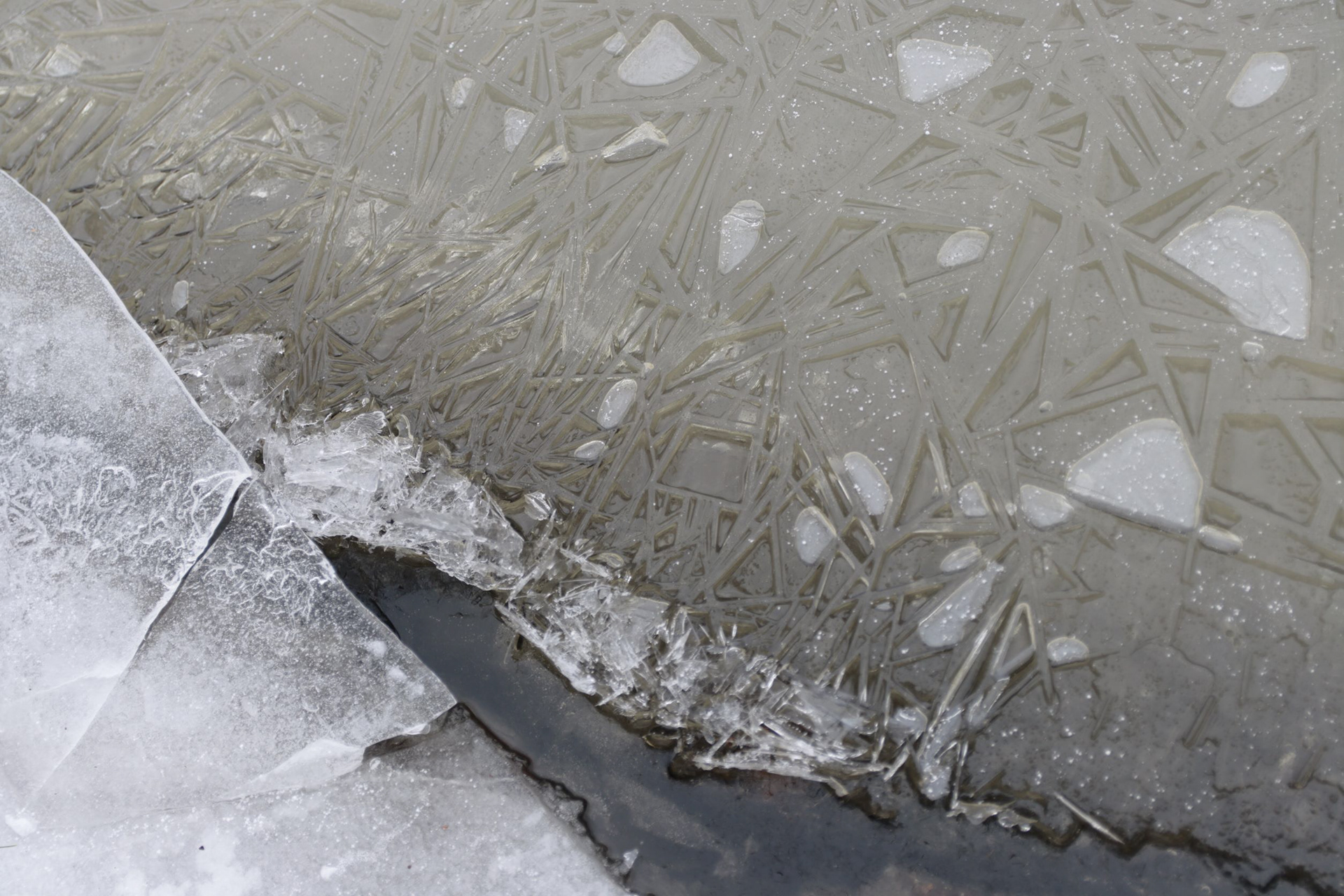
Photo by Isaac Lorton
K: There’s so much going on. As much as I love doing all the hiking around here, and it’s cool you can go to a different trail every weekend if you want, you miss this if you’re always going to different places. If you focus a little – and being here, it’s a small park, so it’s a lot of focus – it helps you pay attention more on the micro-level, which I think is more interesting personally.
I: And maybe what we need at the moment?
K: Right. We’re not traveling the world right now. This is such a pretty tree. I love this.
I: Also how the waters here affect New York and how everything that happens here along the river on a day-to-day basis affects people down river. All the small things that you notice that connect to a bigger larger picture. So many photos of that tree, especially when it’s foggy in the morning.
K: Incredibly spooky and moody.
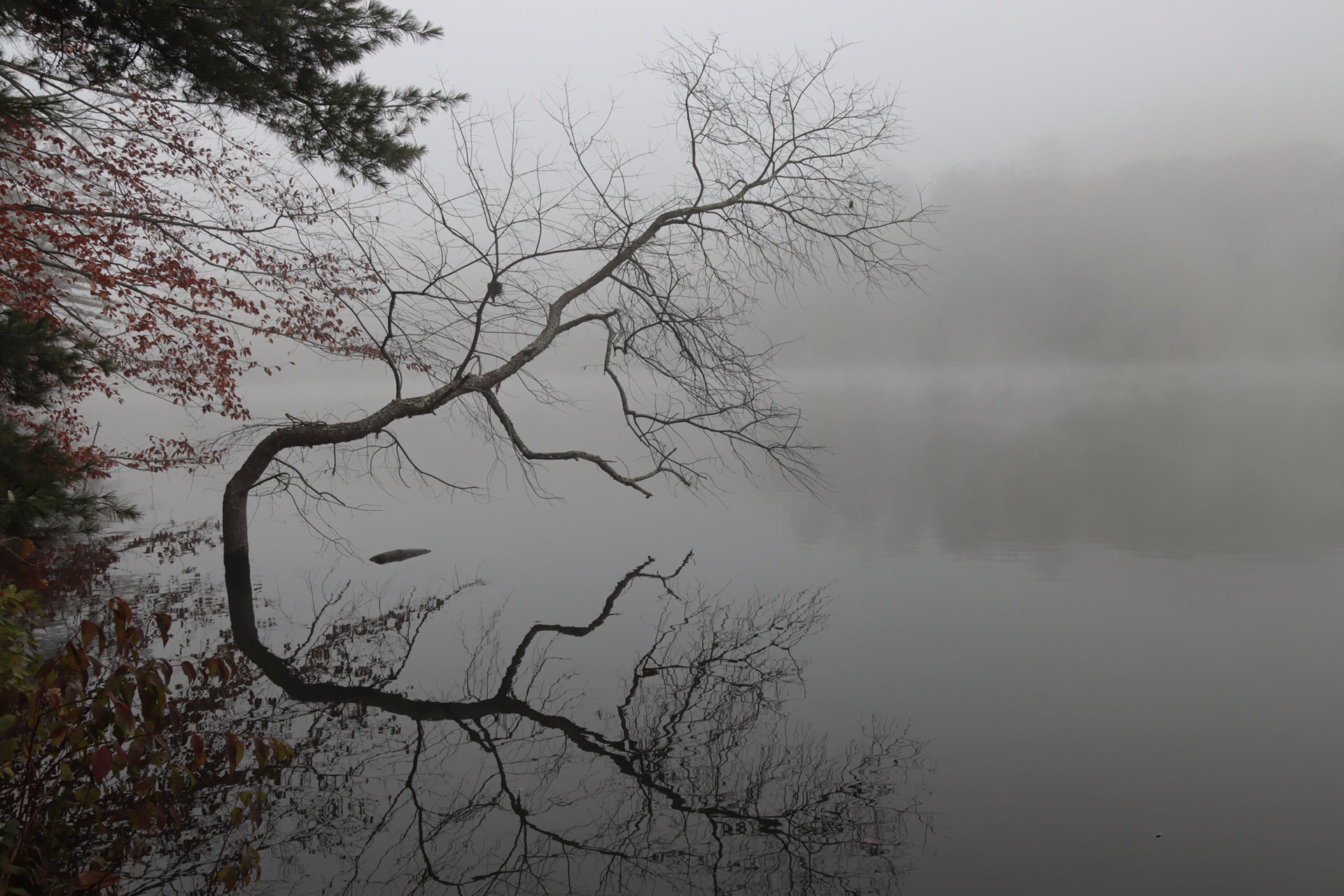
Photo by Isaac Lorton
I: There are so many activities you can do along the river and because of this park. What are some of the activities you do here, seasonally?
K: For me, it’s a lot of walking. I have a lot of joint problems, so walking is one of the few things where I’m like, ‘Yes, I can do this!’ In the non-snowy, non-rainy times, I’m regularly meeting people up at Kilowatt North. Our improv group has been having all of our outdoor rehearsals out here since COVID started, and not meeting in doors. Meeting for people’s birthdays, graduations, random barbeques, ‘my dog is bored.’ We don’t have air conditioning, so in August I’m always walking down here and just jumping in the river. You gotta get your body temperature down, and it’s so nice. I’ll regularly see my neighbors there, too, all swimming. We’re all swimming because it’s so hot.
I: This tree! So I see half a face in it. But maybe that’s because we see faces in everything. What do you see when you see this tree?
K: I think almost like teapot vibes, with a handle and spout. I guess I’ve never really thought to look for more than, wow, that stands out to me and is a cool, pleasing shape. It’s so odd to me. There’s all this going on down here, and then it goes up, and you’ve got these two big trunks. I don’t know if that started as two, grew together, and then apart, or if it branched like that. I don’t know much about botany. I think it’s cool.
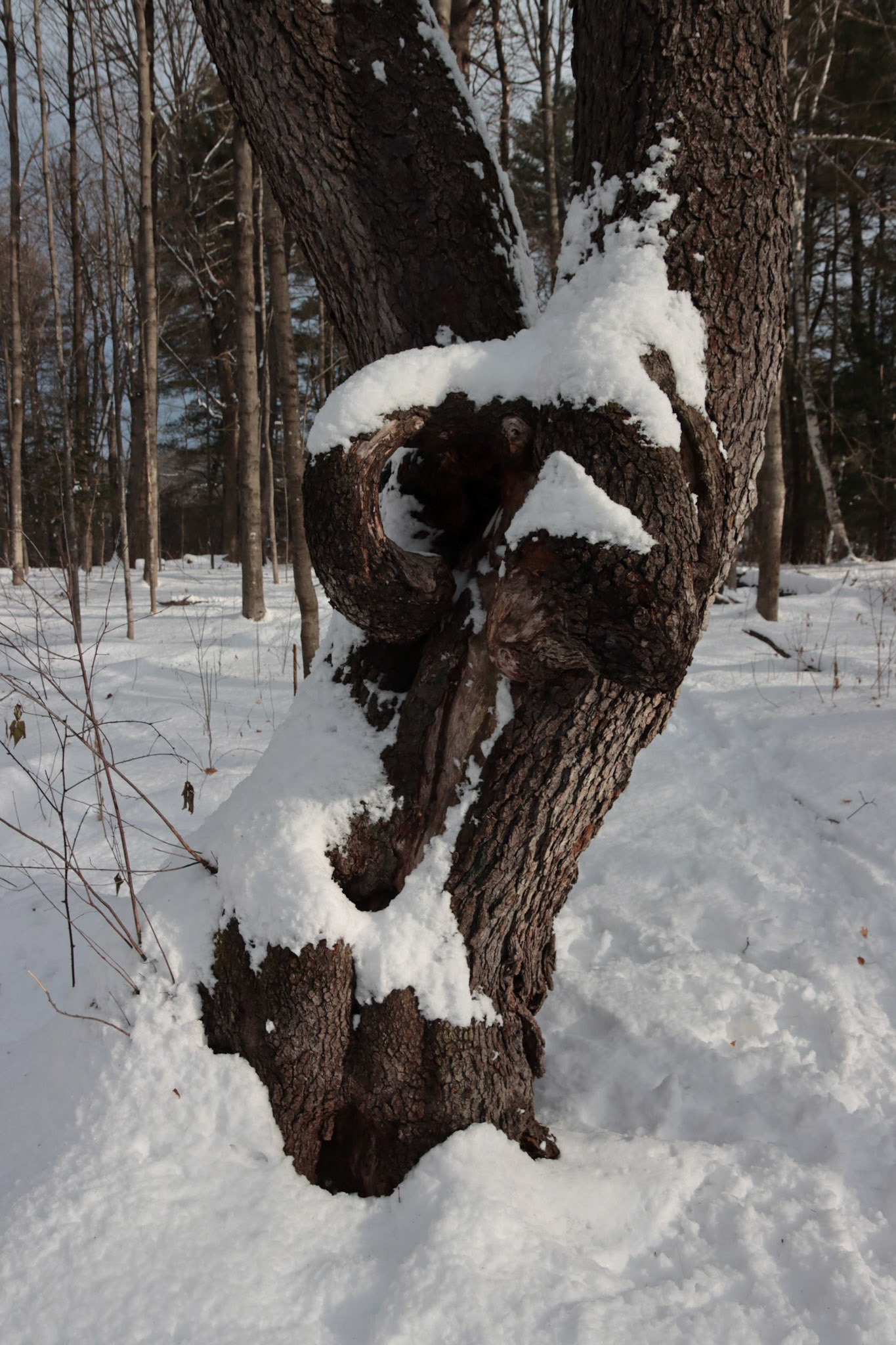
I: It looks cool.
K: There are so many logs down over here. If you’re into fungus, you’ll find really neat looking stuff here. Again, I’m not a huge or knowledgeable forager, but I found a few chicken-of-the-woods, some boar’s head. One time I was over here and there was a bird dance party happening. They were all on the ground doing this little dance thing. None of them were flying. It was almost creepy.
I: Unsettling.
K: What are they doing? Like a bird rave or something.
I: And you just walked in on their party. It is funny the number of animals I’ve stumbled upon and/or scared along this trail. There was a snake this past summer that I swear had it out for me. There was a snake sunning in the trail, and I didn’t notice it. I was walking along on autopilot, and then there was a sudden movement at my feet and it went into the bushes, I jumped back and was like, ‘Oh geez! That was a snake. Alright.’ Then probably two or three days later, there was a snake in the middle of the trail just staring. It wasn’t there when I had walked by originally. Like it had been waiting for me. It didn’t budge, so I went around. I didn’t want to mess with it. Not going to do it today.
I: As far as the project goes as a creative outlet for your writing and photography, is there any other end result of drawing attention to Kilowatt Park?
K: I think my dream outcome would be for other people in this area to do the same thing. I feel like the way to respond to art is more art. I feel like if we, as an Upper Valley community, are able to share our love for our community through our art in a more cohesive and coherent way, that would be the dream.
I: I love the variety here. You got all these pine trees up here, and I don’t know much about trees, but compared to the trees back there, all in one small space.
K: People talk about how there’s a Kilowatt North and a Kilowatt South, but there’s so much more than that. Are you at Kilowatt South soccer field or Kilowatt South dog park or Kilowatt South boat dock? Because those are very different feeling places. Are you on the river trail in the woods or are you on the river trail in the thicket? Is that even North or South, either? I think of it as one park, but a lot of people think about it as two separate parks.
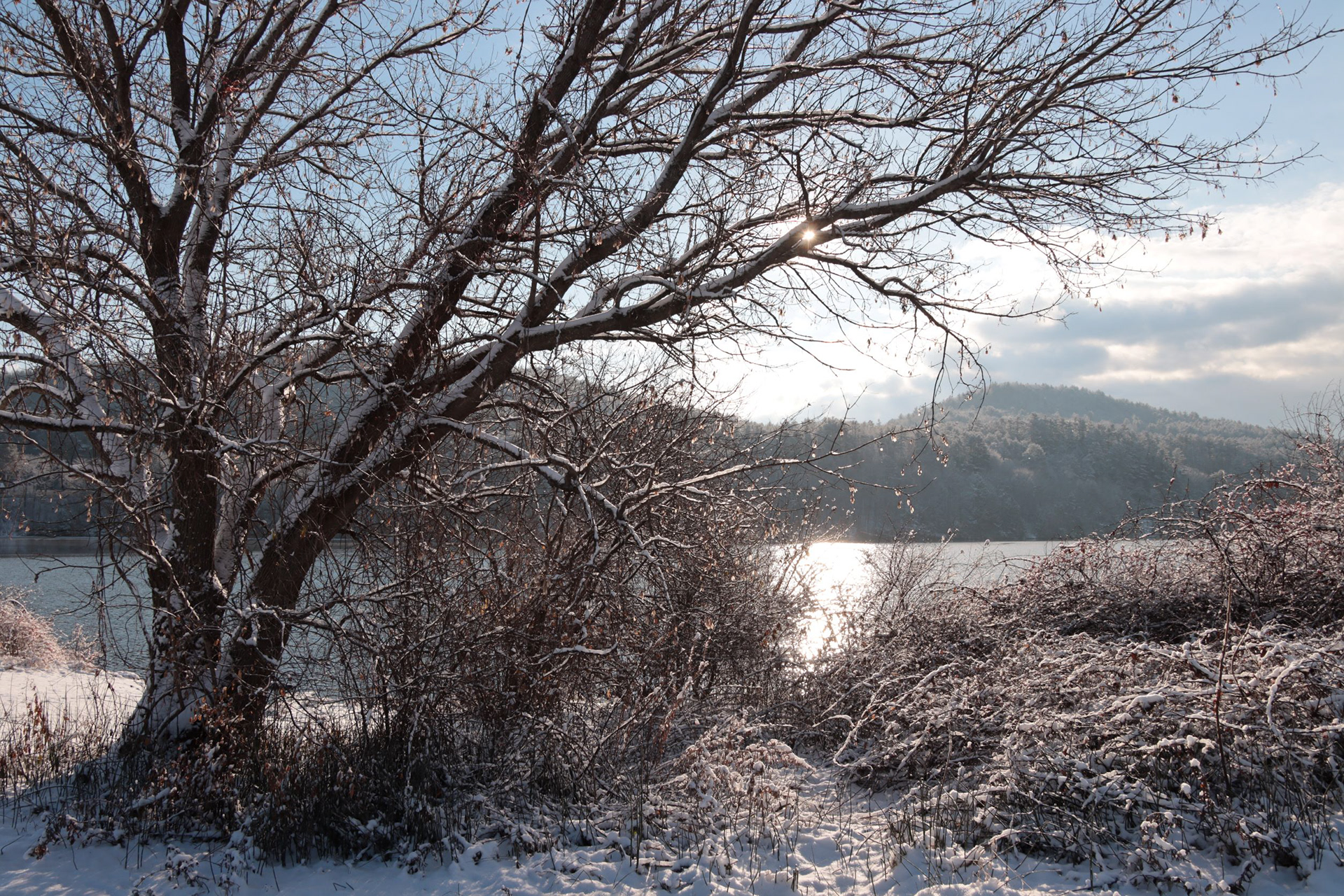
Photo by Isaac Lorton

Photo by Isaac Lorton
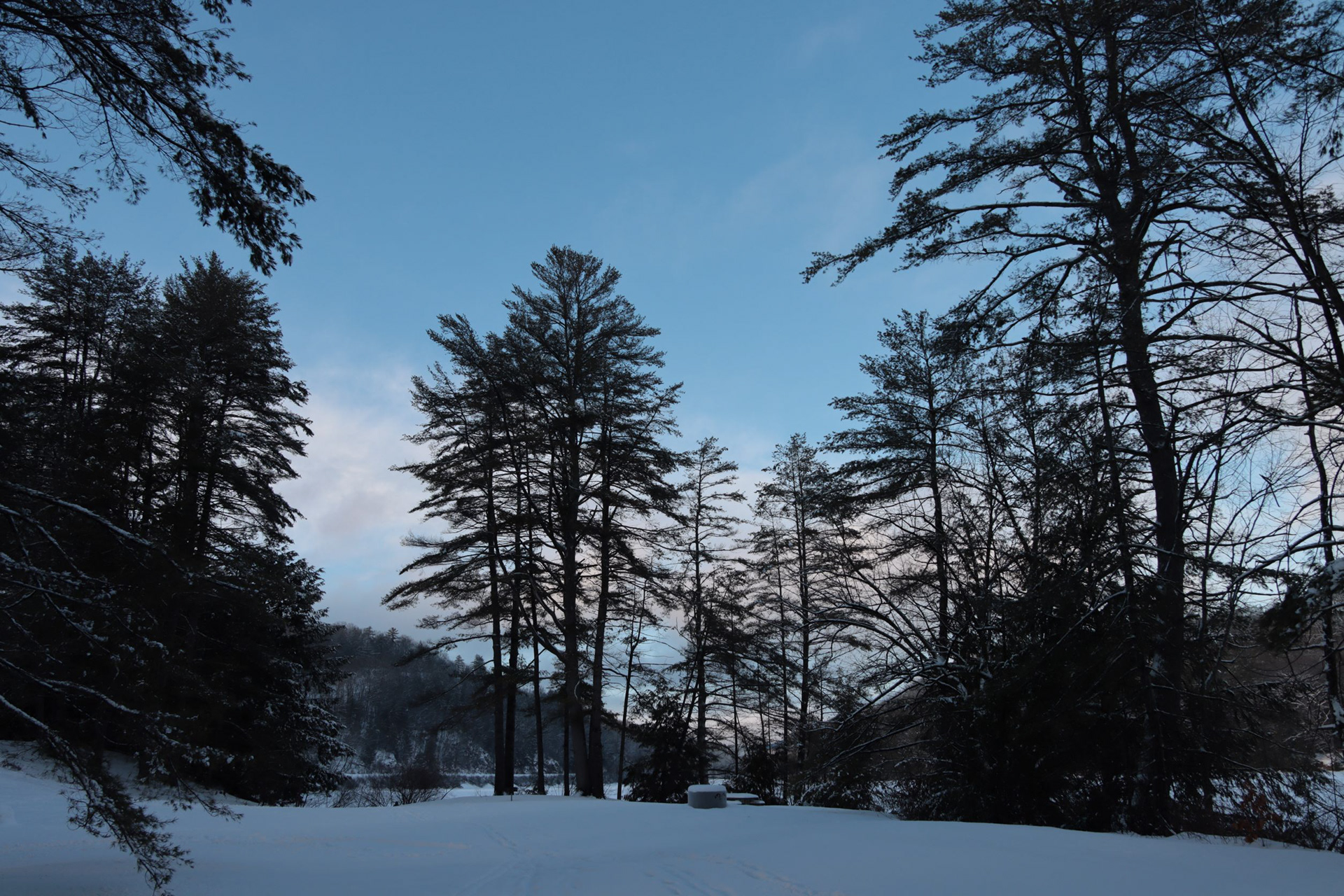
Photo by Isaac Lorton
I: I also think of it as one park. I normally think of it all as the river trail because it seems pretty connected.
K: I know so many folks who swim to New Hampshire and back. I’m not the strongest swimmer, so I wouldn’t be comfortable doing that, but I think it is sweet that we live in a place where that’s a thing people can do. In the summertime, l love this stretch here because the needles are my favorite thing to walk on. They’re so comfy. It feels like the woods laid out a red carpet for me, and I’m all fancy on my pine needle pathway.
I: I feel that. I like to say that grass is the world’s carpet. So, I love going barefoot walking through places with grass, but I probably shouldn’t do that through a bunch of pine needles.
K: This little trail peters off at the end. I wish there were another bench or something just to be like, ‘you made it! To a place!’
I: I step on the little stone marker at the end, then turn around. Sometimes go down to the train tracks and see what that’s like on the day. It has everything.
K: This time of the year, the blue jays and the chickadees have totally taken over. Maybe it’s because I don’t know all of the other birds and they’re like background birds to me, especially by the dock. It’s kind of sad because the vines with the orange cherries all over are oriental bittersweet. It’s super invasive and climbing up all those trees and murdering the crap out of them.
I: They’re so pretty, though.
K: It’s so pretty and I feel bad.
I: The number of photos I’ve taken of them, especially with the snow because of the contrast.
K: It’s so striking. That sort of exemplifies this place, too. It’s not natural. If we were going to be all gung-ho back-to-nature, this place wouldn’t exist because it’s a soccer field and boat launch, and a little strip of trees in between a bunch of power lines. You can’t romanticize it in the same way you can the Appalachian Trail, or something like that, because it is very human centered. That’s not always a bad thing. It gives access. It gives safety. If there weren’t roads and trials here, the kids wouldn’t be playing here, and we would be poorer for it. Sometimes we have beautiful non-native plants here and you have to find the silver lining.
I love textures. I’m so drawn to all the bark and fungus and undergrowth and things like that. I’m not much of a visual artist, like I can’t draw to save my life, but I like to look at things.

Photo by Isaac Lorton
I: Are textures what draw you to the park? Or when you’re writing your poems, what are some of the things that pass through your mind while walking through the park?
K: Most of the time I try to just notice things. Eventually, if I’m good – if I’m well behaved – then I’ll get inspired by something I see. It doesn’t happen every time I go for a walk, and that’s fine. If I’m not paying attention, and I’m in my brain about reliving a conversation that I had the week before then it’s definitely not happening. I don’t know if you ever read Wendell Berry, who has an amazing poem called "How to Be a Poet," and I kinda live by this.
How to Be a Poet
(to remind myself)
(to remind myself)
i
Make a place to sit down.
Sit down. Be quiet.
You must depend upon
affection, reading, knowledge,
skill—more of each
than you have—inspiration,
work, growing older, patience,
for patience joins time
to eternity. Any readers
who like your poems,
doubt their judgment.
Sit down. Be quiet.
You must depend upon
affection, reading, knowledge,
skill—more of each
than you have—inspiration,
work, growing older, patience,
for patience joins time
to eternity. Any readers
who like your poems,
doubt their judgment.
ii
Breathe with unconditional breath
the unconditioned air.
Shun electric wire.
Communicate slowly. Live
a three-dimensioned life;
stay away from screens.
Stay away from anything
that obscures the place it is in.
There are no unsacred places;
there are only sacred places
and desecrated places.
the unconditioned air.
Shun electric wire.
Communicate slowly. Live
a three-dimensioned life;
stay away from screens.
Stay away from anything
that obscures the place it is in.
There are no unsacred places;
there are only sacred places
and desecrated places.
iii
Accept what comes from silence.
Make the best you can of it.
Of the little words that come
out of the silence, like prayers
prayed back to the one who prays,
make a poem that does not disturb
the silence from which it came.
Make the best you can of it.
Of the little words that come
out of the silence, like prayers
prayed back to the one who prays,
make a poem that does not disturb
the silence from which it came.
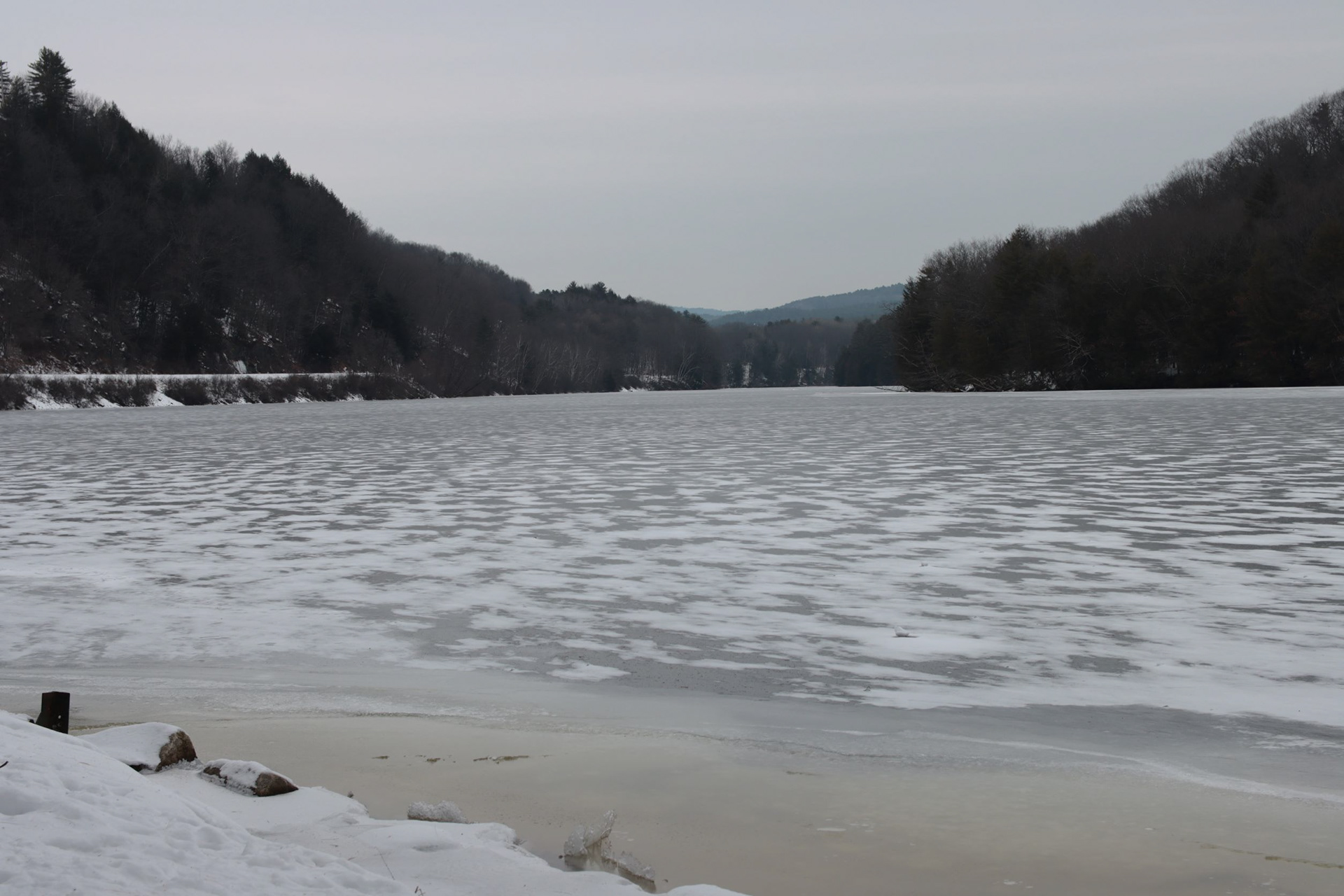
Photo by Isaac Lorton
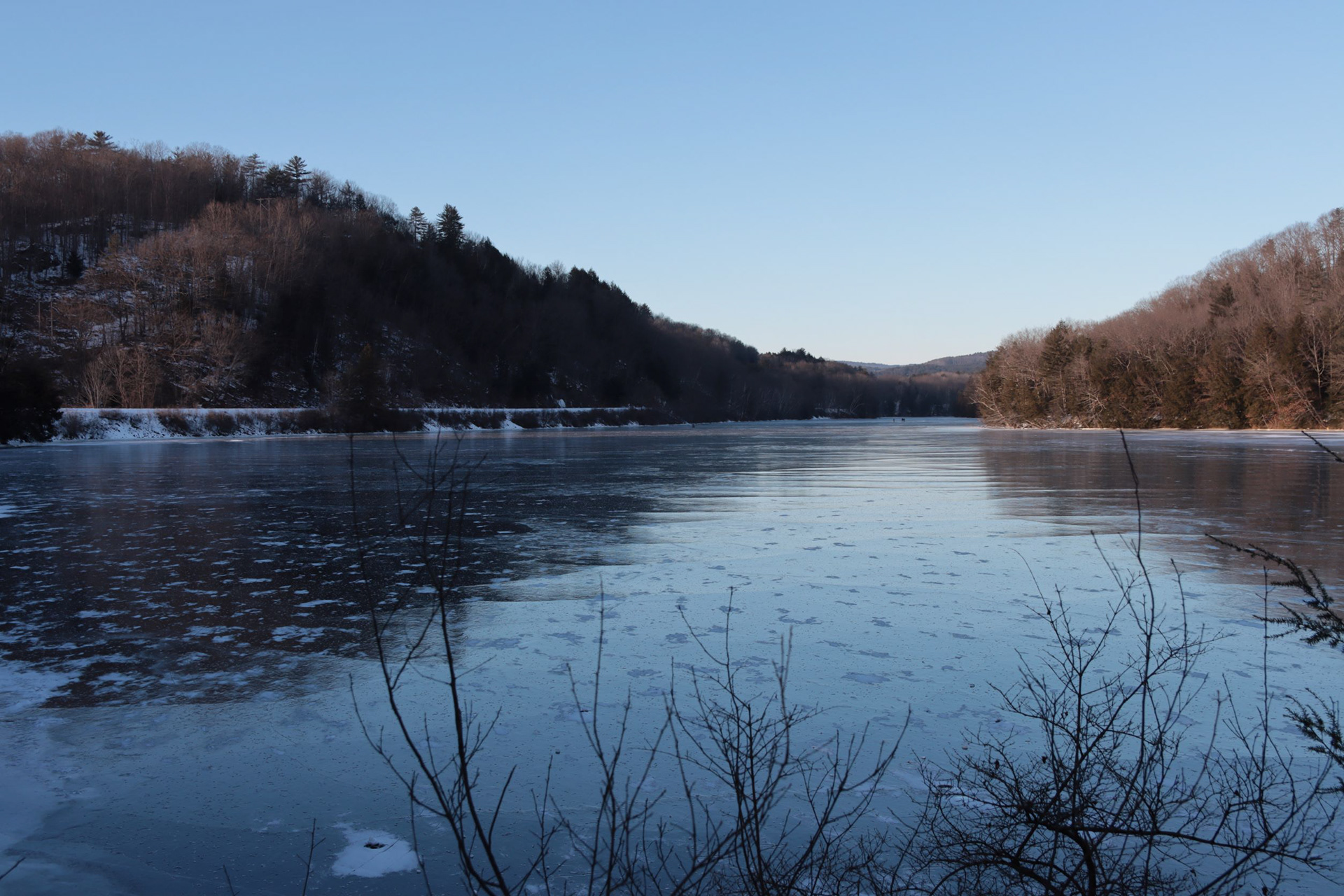
Photo by Isaac Lorton
I: Wow, that was really good timing with the ice cracking.
K: I do a lot of sitting, too. I guess I didn’t include that in my list of what I do down here. I like to sit. Walking is nice, but even walking it’s really easy to distract yourself with thoughts like, ‘Now I’m moving, now things are new, this is where my feet are going to go, don’t fall over, how am I feeling?’ Sitting is nice too. I think my favorite bench in this park is probably the one on the river trail in the middle. It’s the only one that doesn’t leave my legs dangling. It seems to be the right height for me. The view isn’t the most spectacular view, but I feel like I hear more birds there, and things are quieter. You don’t get all the noise from the highway that you do further south and you don’t get so many of the people you do here [in Kilowatt North]. It’s a good place to be quiet and feel being in the trees.

Photo by Isaac Lorton

Photo by Isaac Lorton
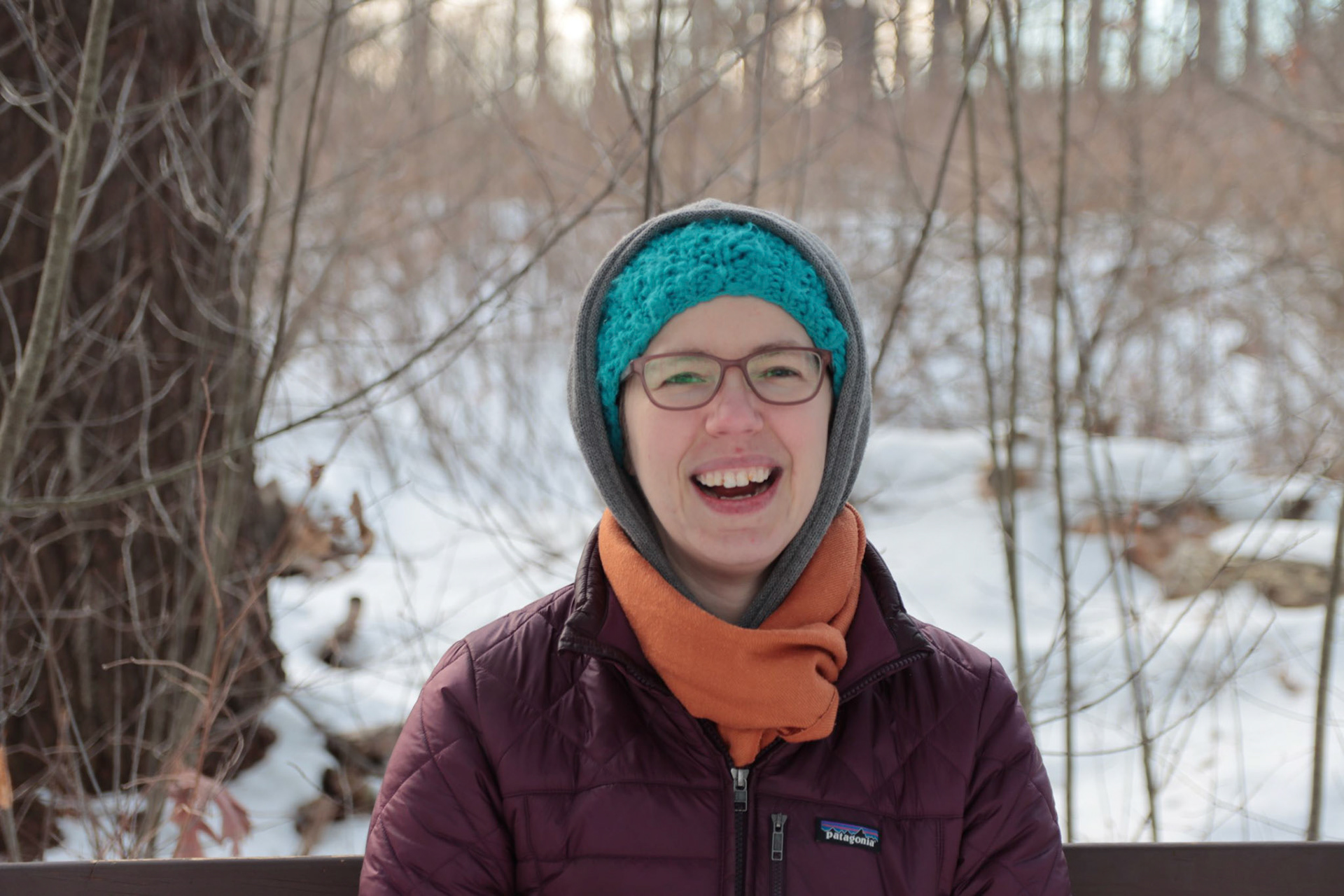
Photo by Isaac Lorton
I: Over the summer, I would bring my journal and write over at that table because it was a nice place to sit and be.
K: It’s wild. You can hear the ice making ice noises. Who thinks about ice having different sounds?
I: Something we think that’s so solid and unmoving, it’s interesting how much it can affect our senses.
K: I saw a wood duck up here once. I didn’t even know what I was looking at at the time, and my friend pointed it out to me. There’s a kind of duck that nests in trees. I have another neighbor who’s obsessed with squirrels, and he comes down here to photograph squirrels all the time. He’s wild about them… There’s so much drama here. A couple weeks ago, there was a juvenile bald eagle that was flying up the river, and these two crows came out and started harassing it, chasing it and yelling at it. It was so funny.
I: There is a crazy amount of drama here. We saw a fox at the bottom of the hill at Kilowatt South once.
K: There’s a nesting pair of bald eagles that lives below the dam, so that’s why we’ll see them regularly up here. I also saw an entire tree-worth of blue jays chasing I think it was a hawk. It was really funny. I didn’t even realize blue jays would mob like crows do, but they definitely do.
I: I feel like blue jays are angry and territorial.
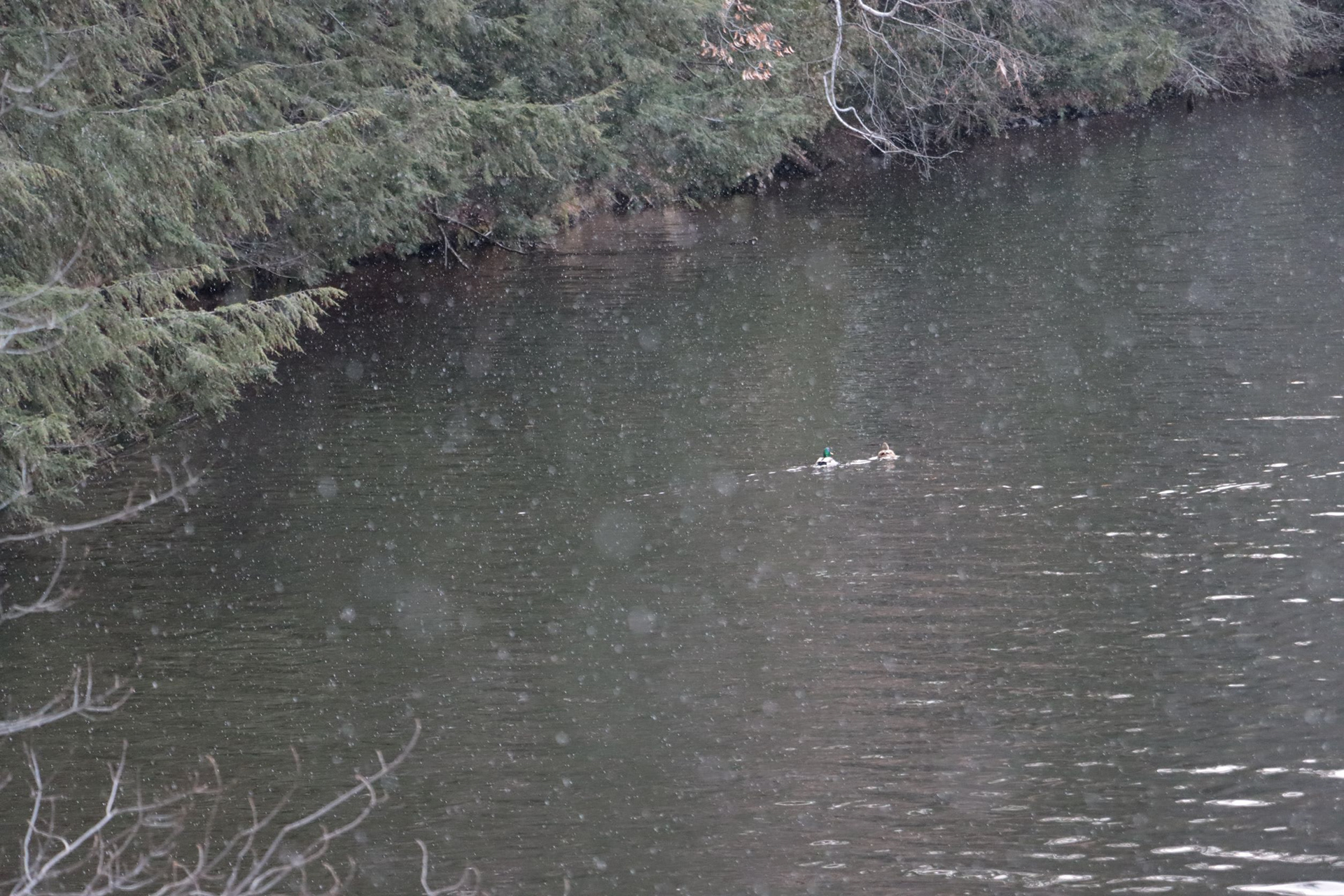
Photo by Isaac Lorton

Photo by Isaac Lorton
I: It’s the world around us, but the smaller world. It’s interesting to see the drama of animals, and I guess we’re not too far off as humans.
K: The plants have drama, too. It’s just slower moving drama so people don’t realize. It’s wild if you pay attention.
I: I make up stories about the trees as I walk along.
K: Scope for imagination as Anne Shirley would say. I think there’s a human desire to manipulate your environment. Whatever it is: I’m gonna paint my bedroom, I’m gonna tag this bridge, I’m gonna throw a rock into the ice and see if it breaks. All those little things to say, I was here! Some are maybe more productive than others, but still. I mean a park is here. Someone was like, you know what, I have a vision for this weird little strip of land between a bunch of power lines.
I: How many times do you think you’ve walked this trail? And how many photos do you think you have of the trail?
K: I have no idea, gosh! It depends. On a day like today, when the light’s good, I’ll take like 50 pictures. But then I’ll come on a day where I’m really feeling uninspired – it’s kind of raining, it’s gray, I don’t really know what I’m looking for – I’ll take like two or three because I feel it’s important to try. In the warmer months I probably walk this trail five or six days a week. Right now, when it gets really cold in the morning and I can’t go in the evening, and it’s the morning or nothing, it’s more like two or three times a week. Because there’s a degree to which I’m able to convince myself to be uncomfortable at 7 am.
I: I understand. I’m very fortunate not to have regular work hours, so I can walk the trail during the day.
K: Working from home since the pandemic has been lovely because it means I have more time in the mornings to go for a walk. But the internet doesn’t wait. It’s nice to do something that’s not in front of the screen. I read a lot of books in electronic format, but lately I’ve been trying to, in the evenings – after 8 – I make sure to switch over to an actual book even if it’s not the one I’m excited about at the moment to make sure I get some of that analog time in.
I think it is difficult now, particularly, because when people are working from home they are expected to be looking at their screen consistently and being in contact, being on their phone. It is hard to get away from that.
What I’ve been doing in the morning is I’ll come down the river trail and back up and it takes me 25 minutes, if I’m not stopping to take pictures. It’s a nice little loop I can do.
I: Do you find that walking sparks creativity?
K: Walking helps my stillness to be more creative. I have a very over-active imagination and I deal with anxiety a lot. So I feel like I need to move around to calm down enough to be still and think because otherwise I can’t. I’ve got bad knees, I can’t run. Cycling, I always feel a little nervous and unstable. Swimming, I’m not that great at. But walking, works for me, most of the time. As long as my legs keep working, I’m going to keep doing it.
K: Handkerchiefs are the most underrated pieces of winter gear.
K: Look at all the different colors of brown there are here. Like this is so red. So incredibly red. And we’ve got the greeny bits and all these tiny little…
I: Pods.
K: You would think there are just gray and brown, but look at all the different types of brown there are here. Like this is so neat.
Someone had tied a pine cone on here as an ornament. It cracked me up because they were tying a pine cone onto a pine tree. It made me laugh so hard.
There are some berries still there.
I: Do you know what kind of berries these are?
K: Red ones.
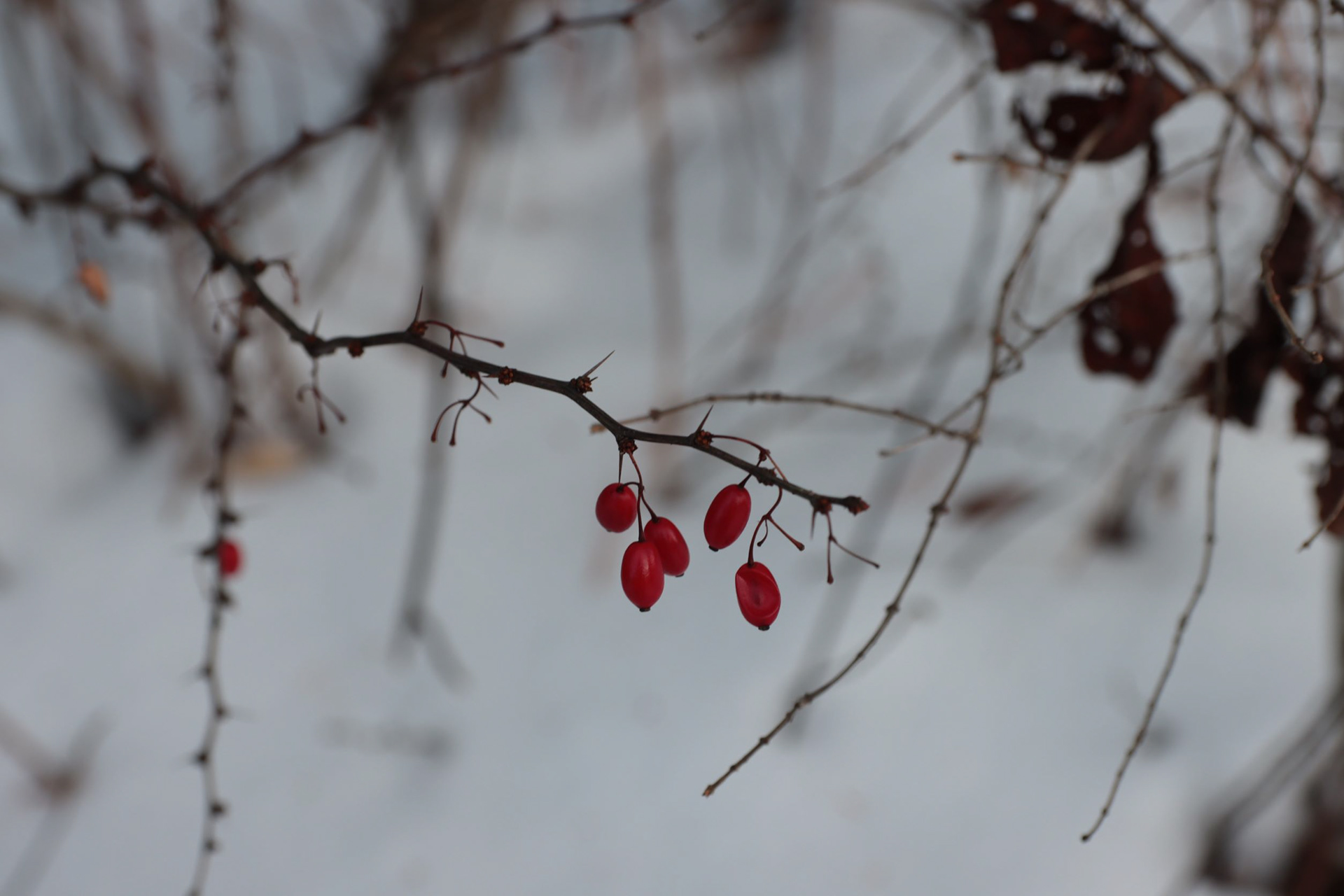
Photo by Isaac Lorton

Photo by Isaac Lorton
I: You were busting out some actual names earlier and I was like well maybe?
K: I make an effort to try and identify the things that I can. There’s a great book called, you might love, called Seeing Trees, and the author, she recommends not getting caught up on naming things. Just come up with your own name for it. If you know what you’re talking about, like the little knubbly blueberry bush, or whatever, and you know it and you know about it, that’s more important than knowing the Latin. All the names are made up. Is this a tree? Is this a bush? What is this?
I: It’s a tree-bush.
K: I’ll admit to being a little bit of a fungus fanatic. I don’t know the names of probably any of them, but they’re so neat.
I: Whatever the turkey mushroom is, they’re my favorite and have all those great colors. Do you do any foraging?
K: Very little. I have a little bit. But I haven’t done so much since I moved up here because I mostly know Midwestern things. I don’t know where stuff is here. I’m pro-foraging but I don’t know a lot of stuff that grows up here because I haven’t grown up with it. My dad always calls me and is like, ‘The ramps are out!’ I’m like, great, have fun! Enjoy your risotto!
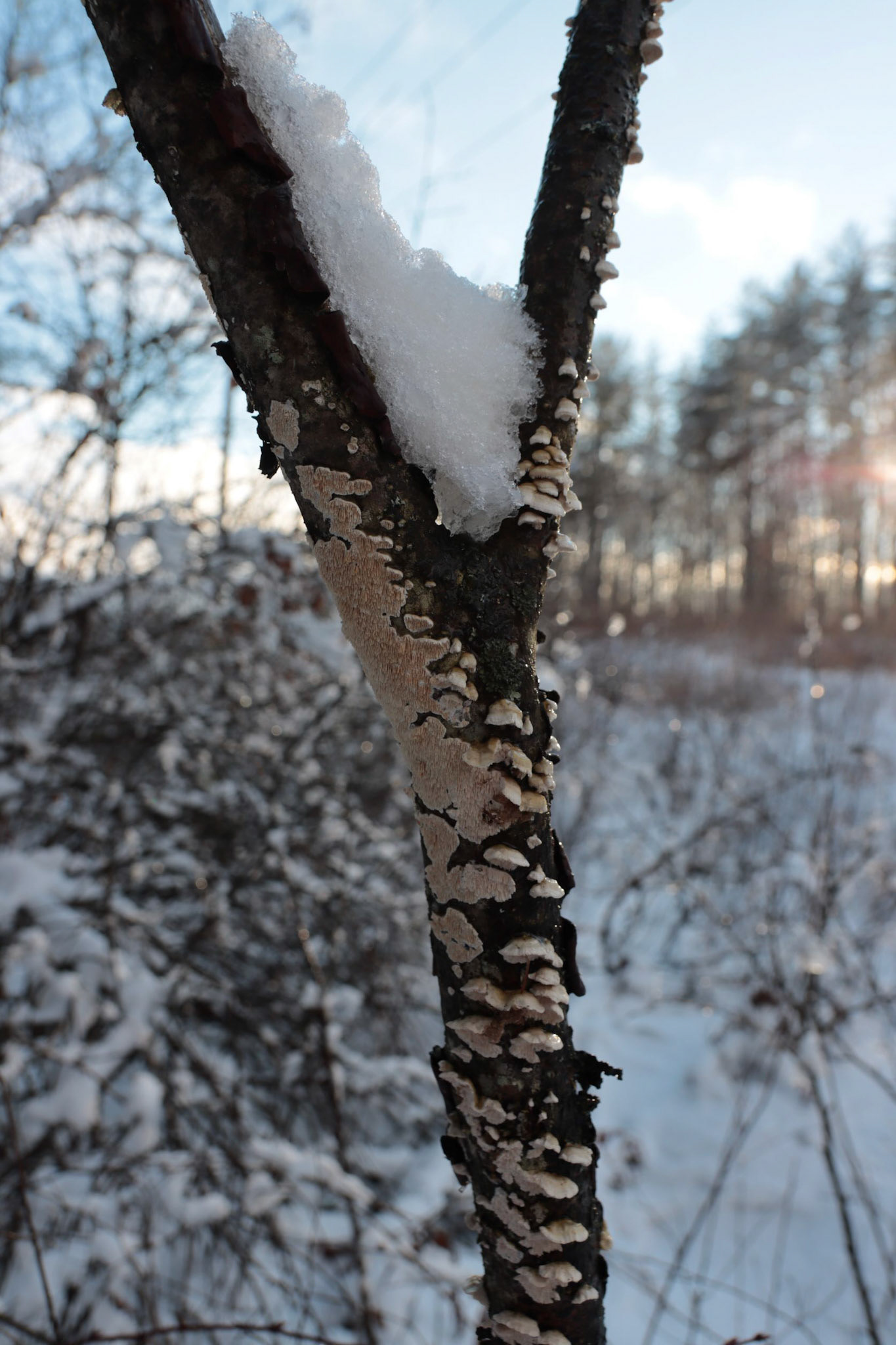
Photo by Isaac Lorton
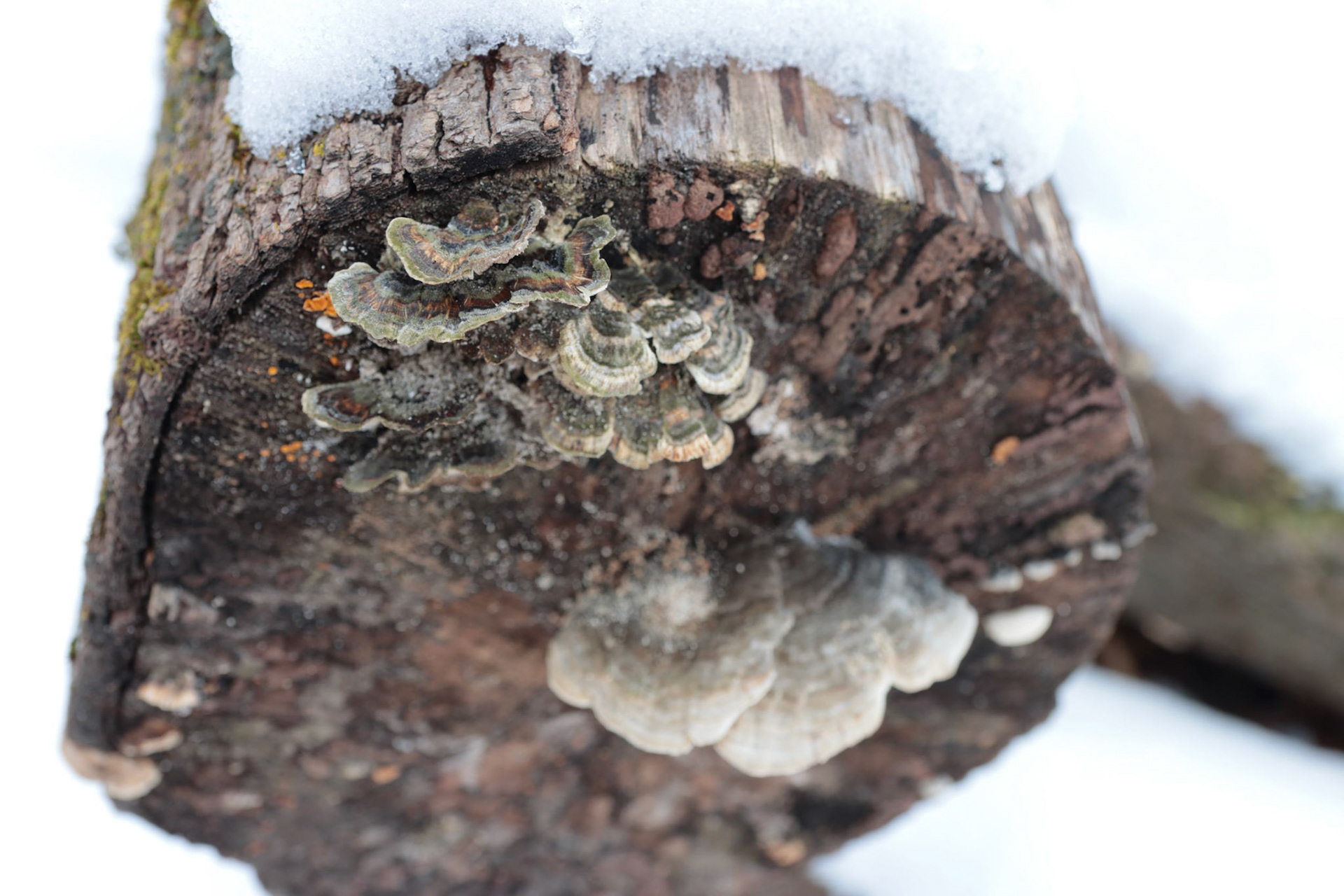
Photo by Isaac Lorton

Photo by Isaac Lorton
I: Like the fiddleheads up here.
K: We made a fiddlehead pizza a few years ago; it was so yummy!
Those are sumac. You can make the best lemonade out of them. Or sumac-ade. I don’t know, it’s really not lemon. When they’re really really bright red, and it hasn’t rained in a little bit because the rain will wash all the powder out, cut a bunch of those, stick them in a bowl of cold water, let it sit for (I let it sit overnight) for a few hours, and then take a cheesecloth and strain it so you get all the bits and bobs and bugs out. It’s super tart, and you can add sugar, syrup or whatever. Citrus doesn’t grow here, so if you’re looking for a local alternative, it’s really great. That stuff grows everywhere around here. There’s no lookalikes, so you’re not going to poison yourself.
They’re striking. I’ve only heard of people using sumac in cooking. I think the European sumac is a little different, but also really yummy.

Photo by Isaac Lorton
K: Here is the only bench where my feet touch the ground. I have short corgi legs. I love little lowrider dogs. They remind me of me. All torso and no leg.
I: Lowrider dogs, love it. Every park needs a poet.
K: At first I was like, you can’t just declare yourself the official poet of Kilowatt Park, but who told me I couldn’t?! If someone yells at me, that’s fine, but until then, it’s me!
I: Or until someone out poets you.
K: We can have a poet off.
I: Poetry slam at Kilowatt Park.
K: That would be awesome.
I: Just bring whatever your weekly poem is.
K: People are so talented.
(Ed note: Kat Mayerovitch has contributed to Junction previously and was not involved in the editorial process for this piece.)
Isaac Lorton is a writer and storyteller, who is happy to be here in this place at this moment with this group of people. Writing, Photographing, Editing.
